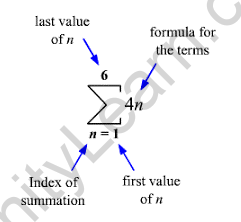Table of Contents
One of the fundamental topics in Arithmetic is sequence and series. A sequence is an itemised collection of elements in which repetitions of any kind are permitted, whereas a series is the sum of all elements. One of the most common examples of sequence and series is arithmetic progression. In a nutshell, a sequence is a list of items/objects that have been arranged sequentially. As the sum of all the terms in a sequence, a series can be highly generalised. However, there must be a clear relationship between all of the sequence’s terms. By solving problems based on the formulas, the fundamentals could be better understood. They are very similar to sets, but the main difference is that individual terms in a sequence can occur repeatedly in different positions. A sequence’s length is equal to the number of terms and can be finite or infinite.

Types of Sequence and Series
The types of Sequence and Series are as follows. A finite series has a finite number of terms, whereas an infinite series has infinite terms.
- Finite and Infinite Sequences: A finite sequence has finite terms, whereas an infinite sequence has never-ending terms or has an infinite count.
- Arithmetic Sequence: A sequence in which the sum or difference of any two consecutive terms is a constant, also known as common difference.
- Geometric Sequence: A sequence in which each term is obtained by multiplying or dividing a given number by the term before it.
- Harmonic Sequence: A sequence formed by taking the reciprocals of an arithmetic sequence’s elements.
- Fibonacci Sequence: A sequence in which the sum of the two preceding terms equals the following term.
Sequence And Series Problems
Question 1: Given a sequence of 4,7,10,13,16,19,22……, find:
- Common difference
- nth terms
- 21st terms
Ans:
Given sequence is, 4,7,10,13,16,19,22……
a) The common difference = 7 – 4 = 3
b) Tn denotes the nth term of the arithmetic sequence and is given by Tn = a + (n-1)d where “a” is the first term and d is the common difference.
Tn = 4 + (n – 1)3 = 4 + 3n – 3 = 3n + 1
c) 21st term as: T21 = 4 + (21-1)3 = 4+60 = 64.
Question 2: Consider the numbers 1, 4, 16, 64, 256, 1024….. Determine the common ratio and the 9th term.
Solution: The common ratio (r) = 4/1 = 4
The previous term is multiplied by four to get the next term.
Tn denotes the nth term of the geometric sequence and is given by Tn = ar(n-1) where an is the first term and r is the common ratio.
a = 1, r = 4 and n = 9
As a result, the 9th term can be calculated as T9 = 1* (4)(9-1)= 48 = 65536.
Question 3 : The second term in a G.P is 12 and the sixth term is 192. Find the eleventh term.
Solution:
Ar = 12 if the second term is given (1)
The sixth term, ar5 = 192 …(2)
We get ar5 / ar = 192/12 by dividing (2) by (1).
⇒ r4 = 16
⇒ r = 2
When we replace r in (1), we get a2 = 12.
ar10 = 6×210 = 6144
As a result, the required answer is 6144.
FAQs
What Is the Difference Between a Sequence and a Series?
A sequence is an arrangement of numbers in a specific order. A series, on the other hand, is defined as the sum of the elements of a sequence.
Q. What is the difference between Finite and Infinite Sequences and Series?
Ans: Sequences: A finite sequence is one that includes the last term, such as a1, a2, a3, a4, a5, a6……an. An infinite sequence, on the other hand, is never-ending, i.e. a1, a2, a3, a4, a5, a6……an…..
A finite series is composed of a finite number of terms, such as a1 + a2 + a3 + a4 + a5 + a6 +……an. The number of elements in an infinite series is not finite, i.e. a1 + a2 + a3 + a4 + a5 + a6 +……an +…..






